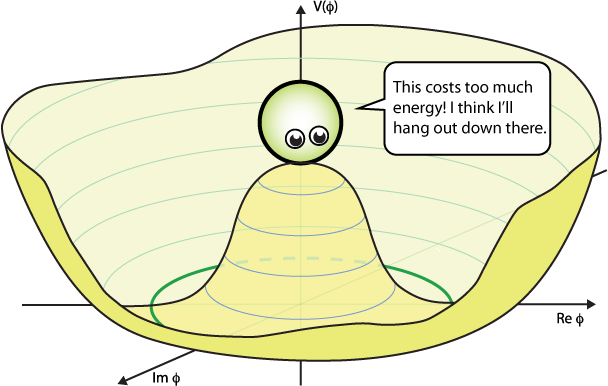The Higgs Boson is an elementary particle in physics. In the Standard Model of physics, it is a reason that most particles have mass. It was predicted theoretically in the 1970s before experimental verification came in 2012. The proof of its existence gave further strength to the Standard Model of Physics.
Index
Theoretical Basis
In the 1960s, particle physicists were struggling with problems regarding the weak force, one of the four fundamental forces. A concept called gauge invariance had great success when applied to the strong force and electromagnetic force. However, it was proving to be a problem when applied to the weak force.
This was because it predicted that the mediating particles for the weak force, the W and Z bosons, should be massless. In reality, experiments showed that the W and Z bosons had mass. Now, physicists either had to discard the gauge theory approach to the weak force or find a separate explanation for why the W and Z bosons had mass.
Prediction
In a set of papers written in the early 1960s, Peter Higgs, Robert Brout, Francois Englebert, and other physicists suggested how the W and Z bosons could have mass without violating the principle of gauge invariance. They suggested that a field (“Higgs field”) is present throughout the universe. This field interacts with the W and Z bosons, giving rise to mass.
They developed the ideas of Yoichiro Nambu, who suggested in 1960 the idea of spontaneous symmetry breaking, a crucial lead in the matter.

A general feature of modern particle physics is that every field has an associated mediator particle. In the case of the Higgs field, the associated particle was the Higgs boson, the so-called “God particle“. This theoretical prediction happened at the same time the Higgs field was predicted, in the 1960s.
However, the actual detection of the Higgs Boson took much longer.
Road to Discovery
The way physicists went about finding the Higgs boson was using equipment called particle accelerators. They are immensely long tubes in which particles are taken to high velocities and made to collide. In the process, the particles form and decay, giving off a series of other particles as predicted by theory.

Physicists knew the properties and decay process of the Higgs boson from theory, so all they had to look out for any sign of these particles. This was easier said than done for several reasons. For one, the energy required in the collisions to produce the Higgs boson was very high. The technology required to get there took several decades, all the way into the 2000s and 2010s.
Further, most decay products of the Higgs boson are commonplace and turn up in other particle collisions. Separating the real Higgs boson decay products from the rest was not easy. Only a few decay products were distinctive, but these were produced rarely.
Along with all this, the production of Higgs bosons is also relatively rare. All in all, the physicists had to perform trillions of collisions before the evidence for the Higgs boson turned up in 2012.
Discovery
The Higgs boson was discovered in June 2012, by two teams working in the Large Hadron Collider (LHC), the world’s largest particle collider. The particle was first identified as consistent with the Higgs boson. Its properties, such as its mass and spin, gave strong indications of the fact. Further, in July, a third independent set of evidence gave further confirmation of the fact.
The formal announcement by CERN that the particle was indeed the Higgs boson came out the next year, in 2013.

Implications For the Future of Physics
The Higgs boson was the last proposition of the Standard Model that needed verification. Its discovery settled this issue. It also opened up new areas of research in physics, possibly leading to “new physics” – physics that is beyond the Standard Model.
There is much to be known about this particle too, such the mystery about its own mass, which is not predicted in theory but must be calculated. It is expected that in answering these questions particle physics will go a long way ahead, and help us gain a deeper understanding of the universe.

